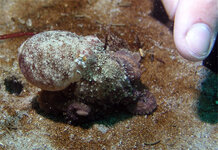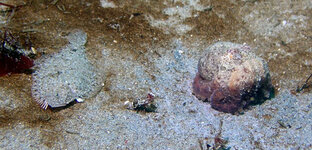- Joined
- Dec 15, 2002
- Messages
- 29
Hey there everyone,
I found this little octopus in Monterey bay last week. I tend to see octopus this size that are very clearly octopus rubescens. They're generally redish and look a lot like the O. rubescens photos in my invert ID book. This one didn't look exactly the same and his behavior was different than any of the others I've seen.
It seems like bimac (bimaculatus or bimaculoides) would be the only other logical option but I couldn't find any false eye spot on this guy. My questions:
- Is the eyespot always visible on a bimac or can it be covered over with chromatophores? The eyespot is always visible in the photos I've seen but none of my ID guides say explicitly whether it's always visible or not.
- Are there any sure fire ways to tell which Monterey area octopus you're looking at? It seems that the suckers are pretty distinctive on the giant pacific octo but all the others are so variable that they leave me a bit confused.
Thanks!
-Jared
I found this little octopus in Monterey bay last week. I tend to see octopus this size that are very clearly octopus rubescens. They're generally redish and look a lot like the O. rubescens photos in my invert ID book. This one didn't look exactly the same and his behavior was different than any of the others I've seen.
It seems like bimac (bimaculatus or bimaculoides) would be the only other logical option but I couldn't find any false eye spot on this guy. My questions:
- Is the eyespot always visible on a bimac or can it be covered over with chromatophores? The eyespot is always visible in the photos I've seen but none of my ID guides say explicitly whether it's always visible or not.
- Are there any sure fire ways to tell which Monterey area octopus you're looking at? It seems that the suckers are pretty distinctive on the giant pacific octo but all the others are so variable that they leave me a bit confused.
Thanks!
-Jared



